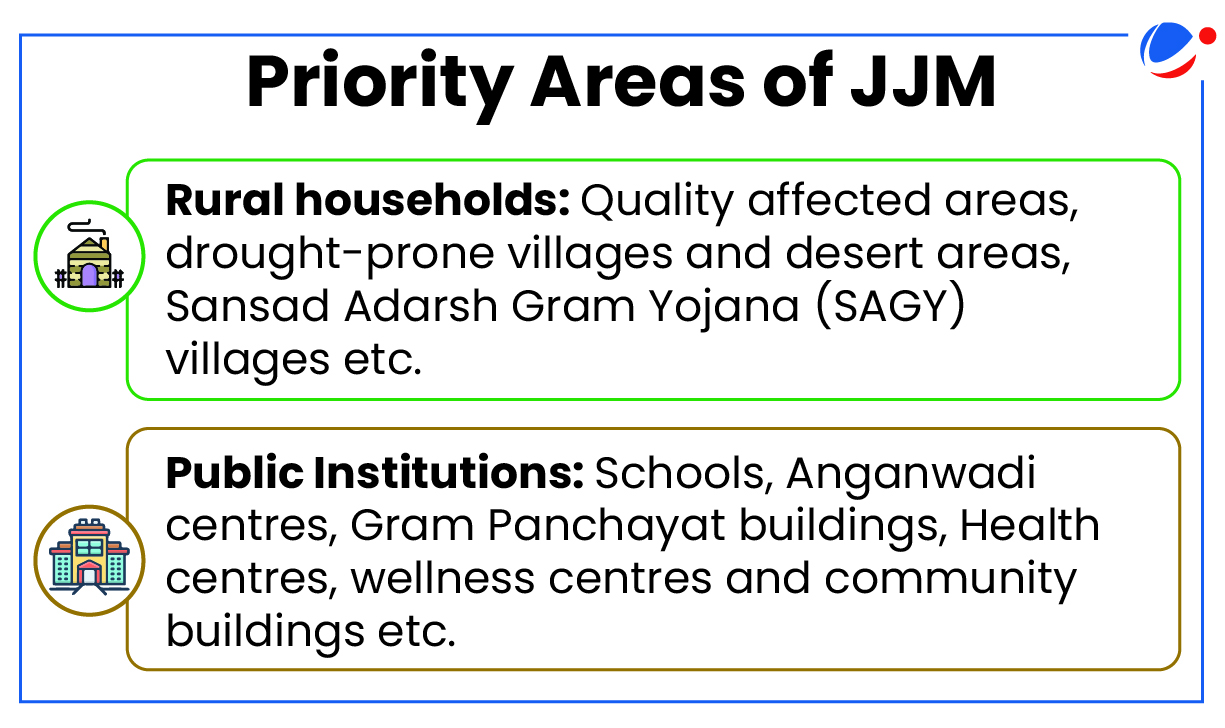Why in the News?
Jal Jeevan Mission (JJM) was extended till 2028 with an enhanced outlay during the Union Budget 2025.
About Jal Jeevan Mission (JJM)
- Launched in 2019 by restructuring and subsuming National Rural Drinking Water Programme (NRDWP).
- At inception, it aimed at providing additional ~16 crore rural households with tap water by 2024.
- Aim: 'Har Ghar Jal (HGJ)' i.e. to provide-
- Functional Household Tap Connection (FHTC) to every rural household
- ensuring adequate quantity (minimum service level of 55 litres per capita per day (lpcd)) of prescribed quality (as per Bureau of Indian Standards)
- on regular and long-term basis
- at affordable charges.

- Nodal Ministry: Department of Drinking Water and Sanitation, Ministry of Jal Shakti.
- Funding pattern: Centrally Sponsored Scheme (Centre and State)
- 90:10 for Himalayan and North-Eastern States.
- 100% for UTs.
- 50:50 for rest of the States.
- Key Features of the scheme:
- Shift of focus for water supply: From 'habitations to households'.
- Decentralized, demand-driven, community-managed water supply programme.
- Gram Panchayat or its sub-committee comprising of user groups plays the role of a 'public utility'.
- At least 5 persons in every village, preferably women, are trained on using Field Test Kits (FTKs) for testing of water quality at village level.
- Jal Jeevan Survekshan (JJS): Launched in 2022 to assess districts and States/UTs on their performance in achieving the objectives of the JJM.
- Central role of women and weaker sections: Minimum 50% members of Village Water & Sanitation Committee (VWSC)/ Pani Samitis are to be women and proportionate representation of weaker sections of society.
- Technological interventions: JJM–IMIS, real-time Dashboard, geo-tagging of assets, sensor-based IoT solutions for water supply measurement, JJM - Water Quality Management Information System (JJM - WQMIS) etc.
- Awareness generation and involvement of stakeholders: Janandolan for water, and encouraging contribution in cash, kind and/or labour and voluntary labour (shramdaan).
Progress and Achievements
- 11 States/UTs have provided tap water connection to all rural households (100%).
- HGJ Reported States/ UTs (confirmed by State/UT Water Supply Department): Mizoram, Himachal Pradesh, Gujarat, Telangana.
- HGJ Certified States/ UTs (Resolution passed by Gram
- Sabha ascertaining claims of Water Supply Department): Goa, Puducherry, Arunachal Pradesh, Punjab, Haryana, A &N Islands, Dadra Nagar Haveli & Daman Diu
- Addition of 75.89% connections since the launch of the mission.
- Households with tap water connections increased from 3.23 crore (17%) of rural households in 2019 to 15.44 crore (79.74%) in February 2025.
- 9,32,440 schools and 9,69,585 Anganwadi centres have tap water supply.

Challenges in Implementation (Standing Committee on Water Resources (2024-25) Report)
- Under-utilization of Funds: Only 30.72% of the funds allocated for the current FY 2024-25 have been utilized.
- Slow rate of saturation in achieving HGJ Status: Only 11 States/UTs have achieved HGJ status due to issues like-
- Long gestation period of Multi Village Schemes.
- Lack of dependable groundwater sources in drought-prone & desert areas, geogenic contamination.
- Terrain challenges in hilly & forested areas.
- Lack of financial and technical capabilities in the States.
- Delay in clearances from nodal agencies, etc.
- Lack of a comprehensive operation and maintenance (O&M) Policy: The responsibility for O&M policies is shifted to the states; only 12 State/UTs have notified O&M Policies for sustainability of rural water infrastructure.
- Issues faced by States include lack of institutional and technical capacity, financial constraints and coordination challenges.
- Insufficient Water Quality Testing Laboratories (WQTL): Presently, only 2160 WQTLs present for ~5.86 lakh villages.
- Further not all labs have accreditation by NABL (National Accreditation Board for Testing and Calibration Laboratories).
- Low focus on water sustainability: Presently, major sources for water under JJM are 52% Ground water and 48% Surface water.
Recommendations (Standing Committee on Water Resources (2024-25) Report)
- Expediting the utilization of funds for implementation of JJM in a time-bound manner with centre-state coordination.
- Provide pro-active assistance to under-performing States.
- Involvelocal elected representatives in the Apex Committee of the State Water and Sanitation Mission.
- Provide assistance to States/UTs in notifying their O&M policy at the earliest.
- Increase number of WQTLs in rural areas and prepare time-bound Plan for NABL accreditation of existing labs.
- Further, 2% allocation to States/UTs can be made mandatory for Water Quality Monitoring and Surveillance (WQM&S) by revising operational guidelines of JJM.
- Formulate schemes/strategy for Water conservation in rural areas.
- E.g. revival and rejuvenation of traditional water bodies, desilting, rainwater harvesting and educating masses.



